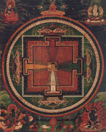

 |
 |
 |
 |
 |
|
This
article is about three indigenous sand-based ‘art’ practices:
the Navajo sandpainting ceremony, the sand mandalas of Tibetan Buddhism,
and Aboriginal ground art. Each of these practices is a distinct
& complex expression of a specific culture, which can only be
properly understood within its cultural context, so I will attempt
to bring some of this context to the fore in talking about them. I
will use the term 'art' to refer to these practices even though
they differ in many ways from what we in the western world usually
think of as art. For example, for the most part, the model for a
western artist today is a talented individual working in isolation,
in a particular medium, producing work to be exhibited &/or
sold. In this model art exists in a sphere separate from the daily
lives of most people & is not meant to have any purpose other
than aesthetic. The process of making and selling art is largely
a commercial enterprise; pretty much devoid of spiritual content.
What's
Different Here? Another
major difference between these three practices and most western
art is the temporal sense associated with their exhibition &
preservation. There is an irony here, however, because while we
try to preserve western art, hanging it in museums with special
machines to regulate the air & light quality, etc., the materials
from which it is made are in themselves impermanent. Over time they
fade, fray and disintegrate. In each of these indigenous forms,
on the other hand, the value of the work is experiential, accessed
through the process of making it. As soon as the artwork is complete,
the materials from which it is made are cleared away, and the work
is destroyed. However, the patterns that the art reproduces are
integral to the culture that makes them. The memory of their form
is embedded in cultural mythology or religious perceptions that
have existed unchanged for thousands of years now. Lastly, unlike
much western art, none of these practices are made in a single medium,
but combine visual, oral and literary elements. Mandala Aboriginal
Dreamtime Through an elaborate kinship system, each aboriginal man and woman inherits the rights and responsibilities for a specific part of the landscape and/or the natural world, along with the Dreaming that created it, and the specific designs that harbour & evoke the ancestral energies of that Dreaming. These rights & responsibilities are always held in common between two individuals, or two groups [one inherits patralineally, and one inherits matralineally] and they manage this inheritance co-operatively. As a result, virtually all aboriginal art of this kind is made by at least two people. Ground
Art Aboriginals
view everything as an interconnected field of subtle energy emanations.
As I mentioned earlier, in Aboriginal cosmology all time exists
at once. Everything contains within its form the memory of its creation,
its history and future, as well as its present, and the designs
used to represent them reflect this perception in various ways.
These images are not abstract designs, but simplified versions of
what is actually seen and/or felt to be there. An image might indicate
the food sources in an area, along with the paths that have led
to them in the past, and might even show events that have occurred
on these hunts. In 1988 a small group of Aboriginal artists colaborated on an Aboriginal Memorial, constructed as a response to the Australian bicentennial, which commemorated 200 years of European settlement. In a memorial to Aboriginal people, past, present and future, they carved 200 hollow log coffins- one for each year of European colonisation- to honour the thousands of Aboriginals who had been killed in that period. The exhibit is now on permanent display in Canberra. Navajo
Sandpainting- Navajo
Sandpaintings are complex healing ceremonies- performed for the
benefit of a tribal member who requests them. Like Aboriginal Dreamings,
Sandpainting rituals are reinactments of the native legends which
provide the foundation for all aspects of Navajo life. There are
several different types of sandpainting ceremonies- known as 'ways'-
Blessingways, used for prevention; Holyways, for healing; and Evilways,
for exorcism. The appropriate 'way' will be chosen by a Hand-Trembler,
or native Shaman, and executed by a trained 'chanter' who will draw
the paintings and perform the songs and dances associated with it. In
the Sandpainting ceremony, the painting functions as a mandala,
with the person who is ill, or out of balance (the Navajo believe
that all illness is a symptom of being out of balance with the natural
order) placed in the middle of the painting. After the painting
is finished, the chanter rubs their skin with sand from the images,
bringing him or her back into the balance depicted by the painting.
Every aspect of this ceremony has significance. The hogan where the ritual takes place is built to precise dimensions in a specific geography. The ceremony always begins at dusk, and is completed at dawn, in accordance with Navajo beliefs of origin and emergence. The images for each painting are determined by the legend it is depicting and the sand is coloured with natural materials collected from sacred sites under specific conditions, each colour indicating a direction and/or other specific properties. In addition, every item and every person who comes into the physical or psychic sphere of the ceremony goes through a purification ritual before they enter.
The
Tibetan mandala, like the other two forms, is a precise rendering
of traditional patterns. The dimensions of the structure must be
geometrically exact. These designs are used to produce the state
of mind for various kinds of mediation and as initiations for monks
into higher states of spiritual awareness. Each of four monks painting
a mandala are working on a different direction. Using long, cone-shaped
metal tools with a hole at one end, sand is tapped onto the surface
of the mandala, a few grains at a time. This meditative act of mandala
creation is accompanied by rhythmic chanting of the names of God,
or traditional prayers. Tibetan
symbology consists primarily of circles, squares, and triangles.
The circle is the key to the mandala- in fact the word mandala means
circle in Sanskrit- it represents the unity of all existence, and
the unbounded chaos of heaven. Squares represent the order of the
four directions and the boundaries of human life on earth. Triangles
stand for the trinity beyond duality and have different meanings
depending on whether the point is upwards or downwards, or the two
are intertwined, when it represents the realised human psyche. The
center of the mandala is almost always a circle, often surrounding
a deity. This center is surrounded by a ritual number of squares
& circles, symbolising the inseparable interconnection of the
two elements. Complex religious ritual draws the divine essence-
the One- down into the center of the mandala, where it is embodied
in the form and therefore accessible to the monks working with the
imagery. The numerous circles within the mandala depict a multitude
of centers existing simultaneously on many levels. To
the person making the mandala, there is a profound sense of identification
with the principles of the mandala. They enter into the form and
directly experience its effects. The 'T' shapes on the sides of
the central square indicate places of entry into the core of the
mandala, while the particular qualities of the shape also serve
to help guard the inner sanctum of knowledge held in that center. Although
the effect of the Tibetan mandala ritual is experienced internally
by each participant, it is practised within a religious context
common to the whole culture, and the enlightenment which is the
goal of Tibetan Buddhism is not an individual goal but one dedicated
to the benefit of all humanity. When the ritual is complete, the
powdered sand, which is believed to be impregnated with the divine,
is poured into running water to disperse its blessings to all. Many
contemporary indigenous artists continue to produce the traditional
forms I’ve discussed here, while others are experimenting with
different forms and/or materials. However, the innate spirituality
and purposeful nature of the ancient forms are almost inevitably
present- at some level- even in the less traditional work. Sometimes
this content disturbs the boundary between politics and art, making
images that assert indigenous peoples and their values in the face
of a world that is often hostile and/or indifferent to them. The 1989 Magicians de la Terre exhibition which was shown at the Pompidou Centre in Paris showcased art from cultures all over the world; current examples of both traditional & contemporary art from indigenous peoples were exhibited next to urban western art. Much of the western artwork was clearly influenced by the beauty and power of the ancient images. It is ironic that all three of the cultures we've been discussing here- Native Americans, Tibetans & Australian Aboriginals- are groups whose worlds are particularly threatened by the world that we as westerners inhabit. In order for us to develop a more ethical and responsible position towards these indigenous cultures, as well as create more rewarding art practices in our own, we need to go beyond being inspired by the aesthetics of their art. This means not just picking and choosing pleasant aspects of other cultures to incorporate into our own, but it is a matter of respect, and beginning to recognise we have something important to learn from these perspectives on life and art, and iving in harmony with the environment which are so different from our own.
Reading List: Native
American Culture & Navajo Sandpainting- Navajo
Medicine Man Sandpaintings, by Gladys Reichard- Dover Publications:
1977 Sandpaintings
of the Navajo Shooting Chant, by Franc Newcomb & Gladys
Reichard, Dover Publications:1975 Aboriginal
Art & Culture- Aboriginal
Art, by Willie Caruana- Thames & Hudson: 1993 Action
for Aboriginal Rights- PO Box 300, Malvern, 3144, Victoria, Australia
Web Site: http://www.vicnet.net.au/~aar/ Tibet- Sacred
Tibet, by Philip Rawson- Thames & Hudson: 1991 General-
The
Reenchantment of Art, by Suzi Gablik Thames & Hudson:1991 Overlay:
Contemporary Art & the Art of Pre-history, by Lucy Lippard-
The New Press:1983 The
Sacred and the Profane: The Nature of Religion, by Mircea Eliade-
Harcourt, Brace & Jovanovitch: 1959 Mandala,
by Jose & Miriam Arguelles- Shambala: 1985 Man & His Symbols, by Carl G. Jung- Arkana: 1964
|
 Sandart-
Ancient & Modern
Sandart-
Ancient & Modern Buddhist
sand-mandalas
Buddhist
sand-mandalas